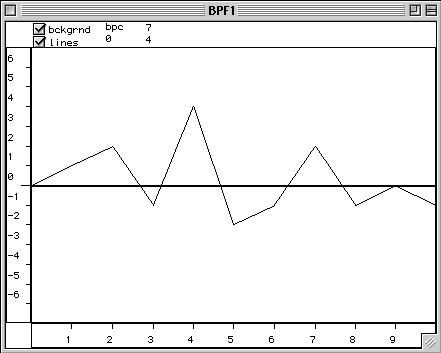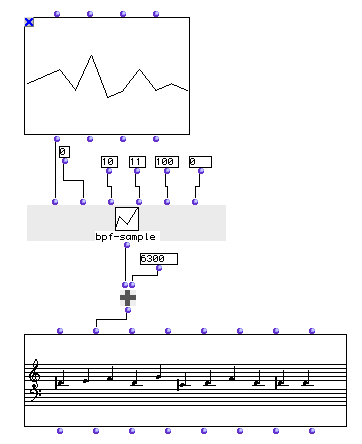OpenMusic Reference
bpf-sample

bpf-sample
(functions module) -- samples a BPF’s values at defined intervals
Syntax
bpf-sample self xmin xmax nbsamples &optional coeff nbdec
Inputs
| name | data type(s) | comments |
|---|---|---|
| self | a BPF object | the BPF to sample |
| xmin | a number | the beginning of the range of x values to sample; defaults to 0 |
| xmax | a number | the end of the range of x values to sample; defaults to 100 |
| nbsamples | a positive integer | the number of (evenly spaced) samples to take between xmin and xmax . |
| coeff | a number | optional; all results are multiplied by this coefficient. Defaults to 1 |
| nbdec | a non-negative integer | optional; the precision of the samples. Sets the number of decimal places to register for each y value calculated. Defaults to 0 |
Output
| output | data type(s) | comments |
|---|---|---|
| first | a list | containing samples of the BPF |
Description
bpf-sample returns the height of the BPF object at defined points on the x axis. The number of samples to calculate is set at nbsamples . These samples are evenly spaced between xmin and xmax , inclusive.
If it is set, all the results are multiplied by coeff . and collected as the output.
The second optional input, nbdec , sets the precision of the samples taken. The default value is zero, which means that the measured height of the BPF at each point will be rounded to the nearest integer. Setting this value higher adds decimal points to the samples.
Examples
Creating a melody from a graphic contour
We will use the bpf-sample function to convert a hand-drawn contour to a melodic line.
First, we draw a contour in a BPF editor:

Then, we pass the BPF to bpf-sample . We will take 11 samples of the function, corresponding to the points between 0 and 10, inclusive. We do not need to use any decimal places so nbdec is set to zero. This would yield the result: (0 1 2 -1 4 -2 -1 2 -1 0 -1), except that coeff is set to 100 (since we are going to use midics) so those values are mutliplied by 100. bpf-sample returns: (0 100 200 -100 400 -200 -100 200 -100 0 -100).
This list is now a list of intervals in midics. All we have to do is decide where to start the melody. We arbitrarily choose D♯, which is 6300 in midics. The result is passed directly to the om+ function, to add 6300 to all the values of the list. The resulting list, (6300 6400 6500 6200 6700 6100 6200 6500 6200 6300 6200), is passed to the lmidic input of a Chord-seq object, and the result is shown below:

| Prev | Home | Next |
|---|---|---|
| band-filter | Up | butlast |